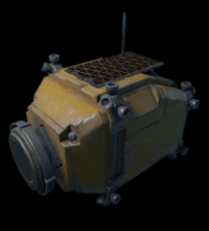¶ Surface Transport
The Adalian economy very frequently requires moving products around between inventories and production chain buildings, as well as Crews between different stations. Ships may be used for that purpose, and with propulsive launches and landings are the fastest way to do this, but rarely the most cost effective.
¶ Hoppers

Rather, so-called “surface transport” is the most common method used. Adalia depends on a small army of small autonomous spacecraft called “hoppers” to carry out this transport. They are able to latch onto cargo modules and escape modules and transport them point-to-point above an asteroid’s surface, following simple ballistic trajectories.
You don’t need to worry about hoppers directly; just worry about what you want to move, and where you want to move it. The hoppers will take care of the rest.
¶ Time Required
Surface transport nominally requires an amount of time that linearly increases with the distance across an asteroid’s surface between the origin and destination lots. That time is nominally 0.5 real-life minutes per km traveled. This required time is sometimes referred to as the “HSTS time”, short for Hopper Surface-To-Surface time. The HSTS time may become very significant on larger asteroids like Adalia Prime.
The HSTS time may increase or decrease according to bonuses or penalties. Most relevantly, the Logistician trait decreases the HSTS time by 5% per Crewmate with it on the Crew that places a surface transport.
¶ Crew Time Required
For surface transport of products, no Crew time is required; they can ‘phone it in’ and the hoppers take care of the rest.
When a Crew is restationing between bases, they are busy for the duration of the HSTS time.
¶ Free Transport Radius
Lots that are less than a certain distance apart may have items or Crews instantly surface transported between them. That distance is called the Free Transport Radius or FTR. The FTR may increase or decrease according to bonuses or penalties. Most relevantly, the number of Merchants on the Crew that places a surface transport will decrease the HSTS time by the class bonus.
With one Merchant on a Crew, the FTR will be 5km. With zero, it will be 2.5km. With a maximum of 5, it will be 7.3km.
¶ Considerations
When siting buildings, they should be placed as close together as possible to reduce surface transport times between them; products will be transported many, many times between those buildings over their lifetimes, and even small transport times will add up tremendously. In particular, if buildings can be placed within the FTR of each other, that will represent a great savings of time.
Roughly the 150,000 smallest asteroids in the belt (those with ~32 or fewer lots) have no lots farther apart than the base FTR, and will enjoy free transport across their entire surface.
¶ Relationship to Launch and Landing Time
The time it takes to tug-launch or tug-land a ship to or from orbit, or for a Crew to eject to orbit or re-station back to the surface from orbit, is equal to the HSTS time to travel between two antipodal lots on the asteroid in question.